 Table Models Sp-Z
Table Models Sp-Z
For all the glory of the consoles, they do
tend to eat up a lot of space. It's nice, therefore, to see the compact
designs of a lot of the table models. Even though there is still some dead
space in a lot of them, compressing the innards of a console into a space
1/3 the volume is still something of a feat. (Smaller sets are also a LOT
easier to force into the Honda.) On this page, I am going to focus
on the horizontal table radios. The second radio I ever bought was
one of these.
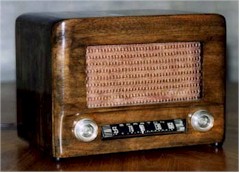
|
Make: Sparton
Model: 5049
Year: 1947-48
Tubes: 35Z5GT, 35L6GT, 12SQ7, 12SK7, 12SA7
Power: 60-cycle
Schematic: Available
Acquired: Aberfoyle, 1993
Made in: London, ON |
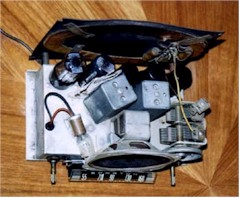
|
I really like this little set. It actually
should be finished in black, but I kind of like it better this way.
It's a pretty minimalistic little radio (moreso when black), but has a
couple of neat little details. The knobs light up as well as the
dial when it is turned on, as one example. I made one modification
to it in that I took out a piece of the paper in front of the bulb in the
hope of getting more light to the far side of the dial and the far knob.
I think it worked.
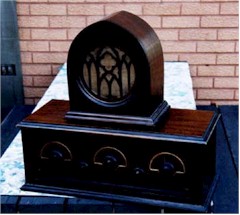
|
Make: Stewart-Warner
Model: 325
Year: 1925
Tubes: 01A (5)
Power: battery
Schematic: Available
Acquired: Christmas 1993
Made in: |
|
This is a great radio with its original finish.
It's the only working version of a radio of this type that I have.
I'm not sure of the make of the speaker. My guess is that it's a
Peerless, but I haven't got much to back that up. Given that we are
lacking all the batteries required to make a set like this go, this one
has had an external power supply built for it. One odd feature of
this radio is that the tubes in it aren't that far removed from light bulbs,
which means the set warms up immediately. It's like having solid
state, circa 1925. The centre dial is the coarse tuning, those on
either side tweak the signal.
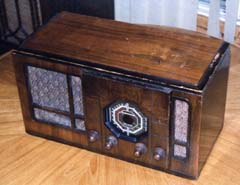
|
Make: Stromberg-Carlson
Model: 130
Year: 1936
Tubes: 6K7 (2), 6A8, 6H6, 6F5, 6F6, 80
Power: 25-cycle
Schematic: Available
Acquired: Ottawa Antique Mkt.,
1994
Made in: Toronto |
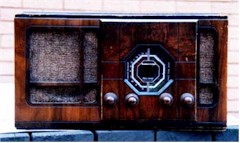
|
I like the lines in this set. It's got
great proportions, a slick, well-lit dial, and an extremely well-built
chassis. I've seen it more than once on the Net, described as "a
great American Deco classic", which irks me to no end, because while this
is a very-well designed set and contains certain deco elements, it is NOT
Art Deco. It tends towards what it referred to as 'Modernistic',
in my opinion. I personally think that 'Art Deco' is the most misapplied
term out there when it comes to radios. To believe what is said in
advertising on the Net, you'd think that anything built between 1930 and
1955 was Deco by default. It isn't, nor are most of the things you
see out there. The majority of radios built after 1940 would best
be described as either Art Moderne, or more accurately as simply Modern.
They are no less special for not being Deco. Why not appreciate things
for what they are?

|
Make: Viking
Model: 40U51-E
Year: 1941
Tubes: 12SA7, 12SK7, 12SQ7, 35L6GT, 35Z5GT
Power: 60-cycle
Schematic: Available
Acquired: Aberfoyle, 1995
Made in: |
|
Viking is another Canadian department-store
brand. This was a cute little AM set that I gave as a wedding gift
to a friend from work. It has been refinished and has a French polish
on it. All the detailing is in the finish, including the black stripe
around the dial and the brown one across the knobs. Needless to say,
there was a large amount of cheating with water paints to recreate the
effect before the finish went back on. Good sound for such a little
set.
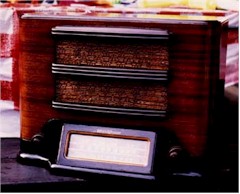
|
Make: Westinghouse
Model: 665
Year: 1939
Tubes: 6SA7, 6SK7, 6J5G, 6SQ7, 6F6G, 5Y4G
Power: 60-cycle
Schematic: Available
Acquired: Aberfoyle, 1993
Made in: Canada (Toronto?) |
|
I had, at one point, three Westinghouse radios
that were basically the same model spread over a ten-year period.
(The others are models 675 and 604.)
I thought it was really neat to be able to see the progression of the design
and chassis while the basic form remained unchanged. This is the
oldest of the three. It was the second one that I purchased.
The original finish was rough, but intact enough that I was able to get
away with recoating it. (The detailing had to be completely redone,
however.) I gave this radio to my friend in Ottawa a few years ago.
It had a good, rich sound. (See the trio.)

|
Make: Westinghouse
Model: 675
Year: 1944
Tubes:
Power: 60-cycle
Schematic: Unavailable
Acquired: Aberfoyle, 1993
Made in: Canada (Toronto?) |
|
This is the second of the Westinghouse trio
(see also models 665 and 604,)
built five years after the previous model. This was the last one
I bought, plus it was the one I owned for the longest time. The basic
form of the radio is consistent, though the grille bars have disappeared
and the detailing has been reduced in favour of more visible wood grain.
This set also had great sound. I gave it as a Christmas present to
a good friend. I let it go because it was one of the very few radios
where I was happy with both the finish and performance. This radio
had to be stripped, and was refinished with the brushing lacquer. (See
the trio.)
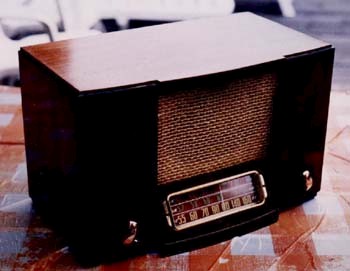
|
Make: Westinghouse
Model: 604
Year: 1949
Tubes: 6SK7 (2), 6SA7, 6SQ7, 6K6G, 6X5GT
Power: 60-cycle
Schematic: Available
Acquired: Aberfoyle, 1993
Made in: Canada (Toronto?) |
|
This was the last of the three Westinghouse
radios in the series (which also included models 665
and 675). I never had to do much of anything
to this radio, save for polishing up the metal in it. It's a shame
that this picture is so dark, because the veneer in it really shows just
how closely-related it is to the other two. The cabinet has become
wider and shorter than the others. This radio is ten years newer
than the first, but I think the original design is still fairly apparent.
Another radio that worked extremely well (how come I never keep these ones?),
I sold this to a coworker who found out about my hobby - one of the few
I actually let go as a straight sale. (See the trio.)
The Westinghouse
Trio
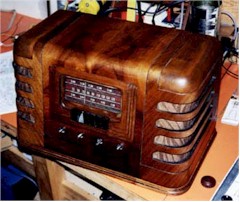
|
Make: Westinghouse
Model: 684-A
Year: c.1940
Tubes:6SA7, 6SK7 (2) 6SQ7, 6F6G, 5Y4G
Power: 60-cycle
Schematic: Unavailable
Acquired: Aberfoyle, 1996
Made in: Canada (Toronto?) |
|
Bought this one on the last flea market day
of 1996. It took some work to get it to the point you see now.
The rod for the tuning control was missing altogether, as one example.
It is now running, but still needs some cabinet work, not to mention a
set of knobs and one pushbutton (that we have tried casting with limited
success). The cabinet was done in some sort of urethane, but I think
I can salvage the labels. It's worth a shot, anyway. Despite
the appearance of the cabinet, there is only one speaker in this radio.
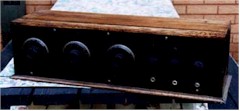
|
Make: Unknown (Home Brew ?)
Model:
Year: c.1925
Tubes: 01A (5)
Power: Battery
Schematic: Unavailable
Acquired: Ottawa Antique Mkt,
1996
Made in: |
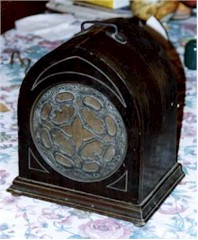
|
These two should maybe not be put together,
but since I know virtually zilch about either of them, and since they could
feasably work in tandem, here they are. The homebrew actually has a metal
label screwed into the underside of the top identifying it as a Radiola
33, which it certainly isn't. I'd really love to know just how it
got there, as well as what happened to the Radiola. I've never tried
running this thing, but I have had it tested out and apparently the final
amplification stage isn't working, so I've left a bad 01A in that socket.
Some of the wiring was redone, probably in the 60's. The speaker
may or may not work. I have no idea who made it, or where it came
from. It has a backing with two knobs on it which has been built
from an old 'Neilson's Chocolate' display. It was in pieces, but
I was able to put it back together. It's an interesting permanent
magnet speaker. I'd love to get these two going.
Table sets still to come:
Phonola (Model unknown) - 1941
Table
Models A-M
Table
Models N-Se
Back
to Main Page
















